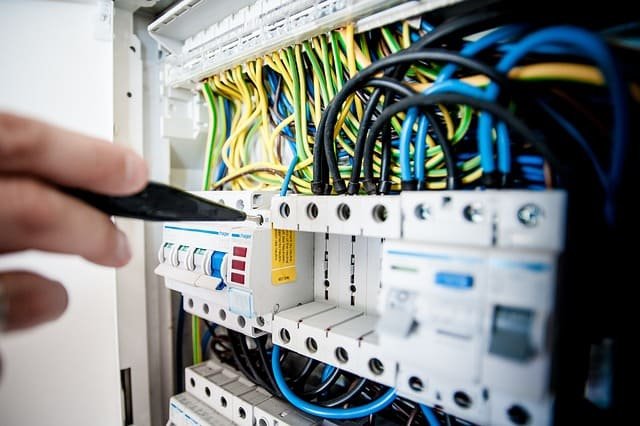When you think of lighting, what comes to mind? Maybe you picture a bright, sunny room or the soft glow of a nightlight. Lighting can change the entire mood of a space. But when choosing between LED lights and traditional lighting, it’s not just about how it looks. It’s about efficiency, cost, and the environment. So, let’s dive into what makes each type of lighting unique and which one is right for your home or business.
Read more – Residential Electrician Milwaukee Wi

The Basics: What’s the Difference?
At first glance, LED lights and traditional lighting (like incandescent or fluorescent bulbs) might seem similar. Both serve the same purpose: they light up a room. But there’s more to the story.
LED (Light Emitting Diodes)
- Small and energy-efficient.
- They turn electricity into light without generating heat.
- They last a long time—way longer than traditional bulbs.
Traditional Lighting (Incandescent & Fluorescent)
- Incandescent bulbs have been around forever.
- Fluorescent lights are common in offices and warehouses.
- These bulbs are less efficient, produce more heat, and don’t last as long as LEDs.
Energy Efficiency: The Power Play
Energy bills are no joke. Whether you’re a business owner or a homeowner, saving on electricity costs is always a win.
- LED Lights: They use up to 85% less energy than incandescent bulbs. That means if you’re using LED bulbs, you’re spending a lot less on your electric bill. Over time, the savings really add up.
- Traditional Bulbs: They waste a lot of energy in the form of heat. If you have incandescent bulbs, they’re consuming power but not effectively using it to produce light.
Take a look at this: According to the U.S. Department of Energy, if every household in the U.S. swapped one traditional bulb with an LED, we’d save around $6 billion in energy costs each year. That’s no small change!
Longevity: When Less Is More
Replacing light bulbs can be a hassle. Whether it’s in your home or office, climbing ladders to change bulbs just isn’t fun. This is where LED lighting really shines.
- LED Lights: These bad boys last around 25,000 hours or more. That’s about 25 times longer than an incandescent bulb. Imagine not having to replace a bulb for years. Plus, many LEDs are built to last much longer than traditional lights.
- Traditional Bulbs: Incandescent bulbs last only around 1,000 hours. That means they burn out quickly, requiring more frequent replacements.
Just think about it. With LEDs, you’re spending less time and money replacing bulbs and more time enjoying the light.
Environmental Impact: Going Green
Let’s face it, the planet needs all the help it can get. The choices we make today impact tomorrow.
- LED Lights: These bulbs are much more eco-friendly. They don’t contain harmful materials like mercury, which is often found in fluorescent bulbs. Plus, their energy efficiency means less carbon footprint overall.
- Traditional Bulbs: Incandescent bulbs are less energy-efficient, and when they break, they can release harmful chemicals into the environment. Fluorescent lights also contain mercury, which can be dangerous if not disposed of properly.
Switching to LED lights? It’s a simple step toward reducing waste and helping the planet.
Cost: Can You Afford to Switch?
Now, the burning question: What about the cost? We’ve all heard that LED lights are more expensive upfront. But is it worth the price?
- LED Lights: While LED bulbs cost more initially, they last longer and use less energy. Over time, they’ll save you money. If you make the switch, you’re looking at potential savings of 50-80% on your energy bills. Talk about a return on investment!
- Traditional Bulbs: These are cheaper up front but cost you more in the long run. More frequent replacements, higher energy bills, and more waste all add up.
Here’s an example: If you replace just 10 traditional bulbs with LEDs, you could save around $200 per year in energy costs. Over the course of 5 years, that’s a savings of $1,000!
Light Quality: Is It Comfortable to the Eye?
We all know how important lighting is to the overall feel of a room. Too bright and you’re squinting. Too dim and you can’t read your book. So, which light source creates the most comfortable and effective lighting?
- LED Lights: They can provide a wide range of light colors. Want warm, cozy lighting in the living room? There’s an LED for that. Need bright, white light in your office for focus? LED can do that, too. The best part? LED bulbs don’t flicker or hum like some traditional bulbs.
- Traditional Bulbs: Incandescent bulbs offer a warm glow, but they’re not as versatile as LEDs. Fluorescent lights are commonly used in offices but often give off a cold, unwelcoming light. And they’re known to flicker, which can be annoying and distracting.
In terms of comfort and customization, LEDs win hands down.
Heat Emission: Does Your Light Bulb Heat Up the Room?
Picture this: It’s a hot day in summer, and you’re trying to cool down your home or business. The last thing you need is a light bulb heating up the room.
- LED Lights: They give off very little heat. This makes them perfect for areas where temperature control is important. Plus, with less heat, you’re not putting extra stress on your air conditioning system.
- Traditional Bulbs: Incandescent bulbs are notorious for turning energy into heat. Ever touch one? It’s HOT. And all that heat can make your air conditioning work harder, costing you more money in cooling.
Want a cooler home and lower AC bills? Swap your old bulbs for LEDs.
What About Business Settings?
If you run a business, lighting might not be the first thing on your mind, but it should be. Lighting affects everything from customer perception to productivity.
- Energy Savings: Businesses use a lot of electricity. In fact, lighting accounts for around 10-20% of energy costs in commercial buildings. Switching to LED lights can reduce your lighting costs by up to 70%. That’s a big deal when you’re running a business.
- Customer Experience: The right lighting can create an atmosphere that’s inviting, exciting, or calming. For example, retail stores often use warm lighting to make customers feel comfortable. Offices use bright, white lights to keep employees alert. No matter the need, LEDs can do it all.
- Maintenance: Traditional bulbs need frequent replacement, and businesses often need to hire someone to take care of this. LED lights last so long that your maintenance costs drop significantly. That means fewer interruptions in your business operations.
Switching to LEDs can make a huge difference for your bottom line.
Final Thoughts: What’s the Best Choice for You?
At the end of the day, it comes down to this: LED lights are the smarter, more efficient, and cost-effective choice. They last longer, save you money, reduce environmental impact, and provide better quality light. The upfront cost might seem higher, but over time, it’s more than worth it.
For homeowners, you’ll see a noticeable drop in your electricity bill, and you won’t have to deal with constantly replacing burned-out bulbs. For businesses, you’ll not only save money but also create a better experience for your customers and employees.
So, the question isn’t “Should I switch?” The question is: Why haven’t you already?
Quick Recap: Why LEDs Are Better:
- Save Money: Up to 85% more energy-efficient.
- Last Longer: 25 times longer than incandescent bulbs.
- Go Green: Less waste, fewer chemicals.
- Reduce Heat: Keep your spaces cooler.
- Versatile: Different colors and brightness to suit any need.
Ready to make the change? Your home, business, and wallet will thank you.


